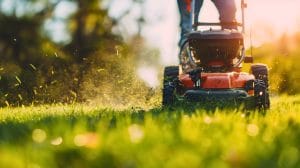A beautiful lawn doesn’t happen by accident. It takes consistent attention, season-specific care, and the right timing. While many homeowners focus only on mowing in summer, truly healthy grass requires action throughout the year. This guide breaks down what your lawn needs in spring, summer, fall, and winter — and why seasonal lawn care matters more than most people realize.

Why Seasonal Lawn Care Matters
Grass is a living system, and like all living things, it responds to its environment. As temperatures rise and fall, and rainfall patterns shift, your lawn’s needs change. Seasonal care:
- Prevents pest and weed infestations before they start
- Builds stronger root systems that survive drought or frost
- Supports greener, thicker growth in peak months
- Saves you money on reseeding, repairs, and expensive chemicals
Understanding these patterns can be the difference between a yard that struggles and one that thrives.
Spring: Rebuild and Renew
After months of cold and dormancy, spring is a critical time to wake up your lawn and lay the foundation for strong summer growth.
Key Spring Lawn Tasks
- Raking and Debris Removal
Winter leaves behind matted grass, mold patches, and debris. Clearing this early lets sunlight and air reach the soil again. - Pre-Emergent Weed Control
Before weeds appear, apply a pre-emergent herbicide to block crabgrass and other invaders from germinating. - Aeration (if needed)
If your lawn feels compacted or has pooling water, core aeration opens the soil so roots can breathe and absorb nutrients. - Overseeding Bare Spots
Spring is ideal for patch repairs. Choose a seed blend matched to your region and sunlight exposure. - First Fertilization
Use a balanced fertilizer to jumpstart new growth. Slow-release formulas give steady energy as soil temperatures rise.
Summer: Maintain and Protect
Summer brings heat, sun, and foot traffic — all of which stress your lawn. The goal during this season is maintenance, protection, and water management.
Core Summer Care Practices
- Mowing Properly
Keep your mower blades sharp and mow high (typically 3–4 inches). Taller grass shades roots and discourages weed growth. - Watering Deeply, Not Daily
Most lawns need about 1 inch of water per week. Water early in the morning and aim for deep saturation, not frequent sprinkles. - Monitor for Pests
Watch for signs of grubs, chinch bugs, or fungal issues. Brown patches can be early warning signs. - Minimize Foot Traffic During Drought
Drought-stressed grass is brittle. Encourage kids and pets to play in designated areas if your yard starts to brown. - Avoid Fertilizing in Peak Heat
Mid-summer fertilization can burn your lawn. If needed, use light, organic options.
Fall: Strengthen and Prepare
What you do in the fall determines how your lawn survives winter and bounces back next spring. It’s a time for deep nourishment and structural improvements.
Critical Fall Actions
- Core Aeration
Fall is the best time to aerate cool-season grasses. It loosens soil, improves water absorption, and enhances root growth. - Overseeding for Density
Overseed in early fall to improve lawn thickness. Cooler nights and regular rainfall help new seeds establish quickly. - Apply Fall Fertilizer
Choose a high-nitrogen blend to support root development and energy storage before winter. - Weed Control (Broadleaf Focus)
Dandelions and clover are most vulnerable in fall. Treat them now to prevent spring resurgence. - Final Mow and Leaf Management
Mow your lawn short before the first freeze, and remove leaves regularly to prevent mold and suffocation.
Winter: Rest and Monitor
While your lawn may be dormant, what you do (or don’t do) in winter affects how well it wakes up in spring.
Smart Winter Lawn Habits
- Limit Traffic
Dormant grass is fragile. Repeated walking or parking on frozen grass can cause long-term damage. - Avoid Salt Damage
De-icing salts from driveways and sidewalks can leach into your lawn and burn the roots. Use lawn-safe alternatives like calcium magnesium acetate when possible. - Keep It Clean
Don’t let branches, furniture, or tarps sit on the grass all winter. These create dead spots by blocking light and moisture. - Plan for Spring
Use winter downtime to schedule your spring services, repair lawn tools, and replenish supplies.
Regional Considerations
Lawn care isn’t one-size-fits-all. Florence and North Alabama homeowners, for example, deal with warm-season grasses like Bermuda and Zoysia, which go dormant in winter and require different fertilization schedules than northern cool-season lawns. Always tailor your care plan to your local grass type, climate, and soil condition.
The Cost of Skipping Seasons
Ignoring seasonal lawn care may not show damage immediately, but over time, problems compound:
- Weeds outcompete grass and spread unchecked
- Soil compacts, choking root systems
- Bare patches emerge and invite erosion or runoff
- Fungus and pests find easier hosts in weakened turf
These issues often require costly repairs, reseeding, or even full sod replacement — expenses that seasonal maintenance could have prevented.
Final Thoughts: Consistency Is the Key
A truly healthy, great-looking lawn is the result of small actions taken consistently throughout the year. Each season plays a role — spring lays the foundation, summer defends it, fall restores it, and winter preserves it.
Whether you manage your yard yourself or hire a local lawn care service, the most important thing is staying on the seasonal schedule. Your lawn’s life cycle won’t wait — and missing a season means playing catch-up the next.
Want to learn more about how North Alabama Service Pros can help you find the right lawn pro for you? CLICK HERE
Want to get a FREE no hassle quote started right now? Fill out the form below.

